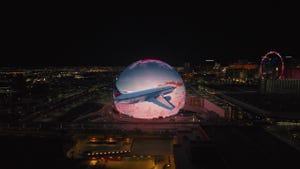Apple Vision Pro Headset Edge: Low Latency
One mostly overshadowed critical advantage of Vision Pro: virtually lag-free, real time viewing
.png?width=1280&auto=webp&quality=95&format=jpg&disable=upscale)
Much has been written about Apple's Vision Pro AR/VR headset: Its lighter form factor, hands-eyes-voice controls, powerful new chips and its steep $3,499 price.
But one key factor arguably has been overshadowed by the headset’s other features: its low latency.
According to Apple, the headset uses a dual-chip configuration of its powerful M2 and R1 chips. The R1 chip, in particular, can stream images to displays in 12 milliseconds “for a virtually lag-free, real-time view of the world.”
That is at least eight times faster than the blink of an eye, which can take between 100 to 400 milliseconds, according to Harvard’s database of useful biological numbers. Market leader Quest 2 and Quest Pro from Meta reportedly come in at around 40 and up to 70 milliseconds, respectively. Meta holds a 75% market share, according to Statista.
Reducing lag will cut down on nausea when using the headset, as images are quickly loaded. Nausea results from moving the body in one direction but images are slower to follow.
According to a 2022 paper from the University of Nevada at Reno, “VR sickness is a major concern for many users as VR continues its expansion towards widespread everyday use.”
Apple did not disclose much about the R1 chip, only saying it is specially tasked with processing the input from 12 cameras, five sensors and six microphones to stream images to displays. This includes a lidar scanner.
Meanwhile, the M2 runs the headset’s new operating system visionOS and executes computer vision algorithms efficiently, according to Apple.
To be sure, the headset’s stretchable fabric strap, presumably lighter frame (since Apple separated the battery from the headset but did not disclose the actual weight), use of hands, eyes and voice to control it rather than wielding manual controllers – all add to a potentially better user experience.
But if users feel nauseated using the headset, it arguably matters less that the device is lighter, softer or more intuitive to use.
Soldiers Nauseated After Using HoloLens
Consider Microsoft’s HoloLens AR/MR headset, which outfitted the U.S. Army following a $21.9 billion contract win in 2021.
Testing of the headsets in mid-2022 resulted in more than 80% of soldiers reporting symptoms that included headaches, eyestrain and nausea after less than three hours of use, according to a 2022 report in Bloomberg.
Nevertheless, the military is determined to go forward with the AR/MR headset. Last December, the Army said it awarded Microsoft a “task order” to improve the HoloLens based on feedback from soldiers.
“The Army is fully committed to IVAS (Integrated Visual Augmentation System) and the leap-ahead capability it will provide for soldiers to prevail in the battlefield," the Army said in a statement.
This article first appeared on IoT World Today's sister site, AI Business.
About the Author
You May Also Like
.png?width=100&auto=webp&quality=80&disable=upscale)
.png?width=400&auto=webp&quality=80&disable=upscale)






